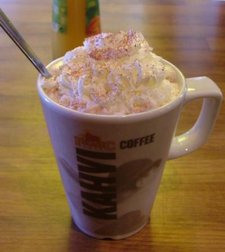Cream
|
|
- This article is about cream, the food item. There are articles on the colour cream, the 1960s rock band Cream and the nightclub Cream.
Cream is a dairy product that is composed of the higher-fat layer skimmed from the top of raw milk before homogenization. In the raw milk, over time, the lighter fat rises to the top. In the industrial production of cream this process is accelerated by using centrifuges called "separators". In many countries cream is sold in several grades depending on total fat content. Cream can be dried to a powder for shipment to distant markets.
Cream produced by cattle (particularly Jersey cattle) grazing on natural pasture often contains some natural carotenoid pigments derived from the plants they eat; this gives the cream a slight yellow tone, whence the name of the yellowish-white colour cream. Cream from cows fed indoors, on grain or grain-based pellets, is white.
In the US, cream is usually sold as:
- Half-and-half (12% fat)
- Whipping cream and whipped cream (30%)
- Heavy cream, or heavy whipping cream (36%)
- Manufacturer's cream (40%), mostly available from food-services supply wholesalers rather than groceries
Also common in the US is sour cream, which is cream that has been subjected to a bacterial culture that produces lactic acid, producing a sour taste, and that thickens the cream as well.

In the UK, cream is usually sold as:
- Half cream (12%)
- Single cream or Light cream (18%)
- Whipping cream (35%)
- Double cream (48%)
In the UK, clotted cream is a very high fat (55%) product processed with heat.
Crème fraîche (a product with a French name and widely available elsewhere) is a heavy cream slightly soured with bacterial culture, but not as sour or as thick as American sour cream. Mexican crema (or cream espesa) is similar.
Cream with 30% or more of fat can be turned into whipped cream by mixing it with air. This roughly doubles the cream's volume as air bubbles are captured in a network of fat droplets. (Whipped cream is said to have been invented in 1671 by François Vatel for a banquet in honor of Louis XIV, though it's likely that it was actually known long before this.) If the whipping is continued, the fat droplets stick together and form butter; the remaining liquid is buttermilk.
Cream is the principal constituent of butter.
Ice cream is made with milk, milk proteins (casein), cream and flavorings, frozen while stirring to limit the size of the ice crystals. Premium ice creams usually contain more milk fat.
The term cream or creme is used in food, pharmaceuticals, and cosmetics to refer to a variety of substances of a consistency similar to or thicker than that of cream, such as chocolate cream or moisturizing cream.
See also
de:Sahne eo:Laktokremo fr:Crème fouettée nl:Slagroom ja:クリーム fi:Kerma sv:Grädde
